The global lane control signals market is projected to grow from USD 859.2 million in 2025 to approximately USD 1,212 million by 2035, recording an absolute increase of USD 352.8 million over the forecast period. This translates into a total growth of 41.1%, with the market forecast to expand at a compound annual growth rate (CAGR) of 3.5% between 2025 and 2035. The overall market size is expected to grow by nearly 1.41X during the same period, supported by increasing investments in intelligent transportation infrastructure, growing emphasis on highway safety management, and rising adoption of advanced traffic control systems across global transportation development projects.
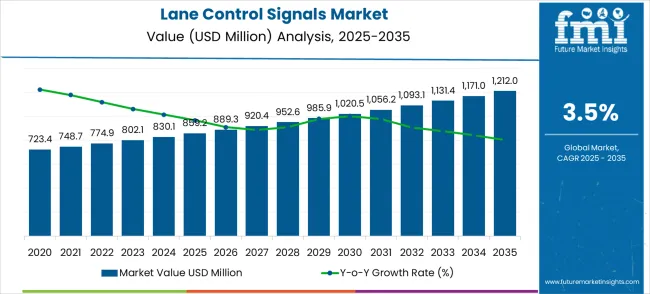
| Metric | Value |
|---|---|
| Estimated Value in (2025E) | USD 859.2 million |
| Forecast Value in (2035F) | USD 1,212.0 million |
| Forecast CAGR (2025 to 2035) | 3.5% |
From 2030 to 2035, the market is forecast to grow from USD 1,009.3 million to USD 1,212.0 million, adding another USD 202.7 million, which constitutes 57.5% of the overall ten-year expansion. This period is expected to be characterized by the integration of connected vehicle communication systems, the development of automated traffic management platforms, and the advancement of energy-efficient LED technologies for enhanced visibility and reduced operational costs. The growing emphasis on sustainable transportation infrastructure and intelligent mobility solutions will drive demand for advanced lane control systems with integrated IoT capabilities and real-time traffic optimization features.
Between 2020 and 2024, the lane control signals market experienced steady growth, driven by increasing awareness of highway safety benefits and growing recognition of intelligent transportation systems' effectiveness in managing traffic flow and preventing accidents. The market developed as transportation authorities recognized the potential for lane control signals to enhance roadway safety while supporting dynamic traffic management requirements. Technological advancement in LED display technologies and wireless communication systems began emphasizing the critical importance of maintaining signal visibility performance while extending operational life and improving cost-effectiveness.
Market expansion is being supported by the increasing global demand for intelligent highway infrastructure and the corresponding shift toward dynamic traffic management systems that can provide real-time lane control while meeting modern transportation requirements for efficient traffic flow optimization and safety enhancement. Modern transportation authorities are increasingly focused on incorporating lane control signals to enhance highway safety performance while satisfying regulatory demands for advanced traffic control systems and improved accident prevention capabilities. Lane control signals' proven ability to deliver superior visibility enhancement, operational reliability, and traffic flow optimization makes them essential components for modern highway infrastructure development and intelligent transportation system applications.
The growing emphasis on smart highway development and connected infrastructure is driving demand for high-performance lane control systems that can support integrated traffic management platforms and real-time communication with traffic control centers across highway, bridge, and tunnel applications. Transportation authority preference for technologies that combine operational excellence with energy efficiency credentials is creating opportunities for innovative lane control signal implementations in both traditional and emerging traffic management applications. The rising influence of autonomous vehicle integration and connected transportation system development is also contributing to increased adoption of advanced lane control products that can provide automated communication with vehicle systems and traffic management platforms.
The market is segmented by signal type, application, and region. By signal type, the market is divided into reflective material signs and LED signs categories. Based on application, the market is categorized into urban roads, highways, bridges, and tunnels. Regionally, the market is divided into North America, Europe, East Asia, South Asia & Pacific, Latin America, and the Middle East & Africa.
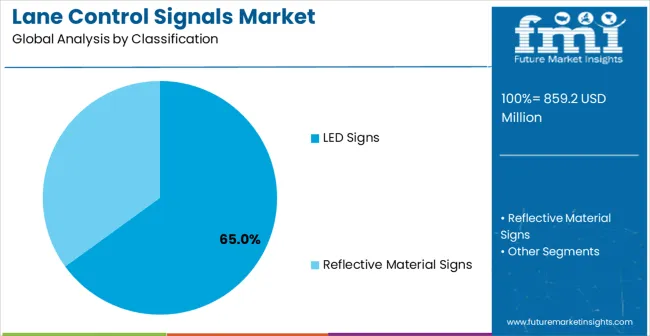
The LED signs segment is projected to dominate with 65% market share in the lane control signals market in 2025, maintaining its position as the leading category of signal types. Transportation authorities and highway infrastructure developers increasingly utilize LED lane control signals for their superior visibility characteristics, energy efficiency performance, and advanced communication capabilities across diverse traffic management applications. LED technology's enhanced brightness performance and programmable display capabilities directly address the operational requirements for effective lane control communication and efficient traffic flow management in both daytime and nighttime conditions.
This signal type segment forms the foundation of modern lane control applications, as it represents the technology with the greatest versatility and established infrastructure compatibility across multiple traffic management systems. Transportation authority investments in LED technology solutions and visibility optimization continue to strengthen adoption among highway infrastructure developers. With traffic management organizations prioritizing operational effectiveness and consistent visibility performance, LED lane control signals align with both energy efficiency objectives and safety assurance requirements, making them the central component of comprehensive traffic control strategies.
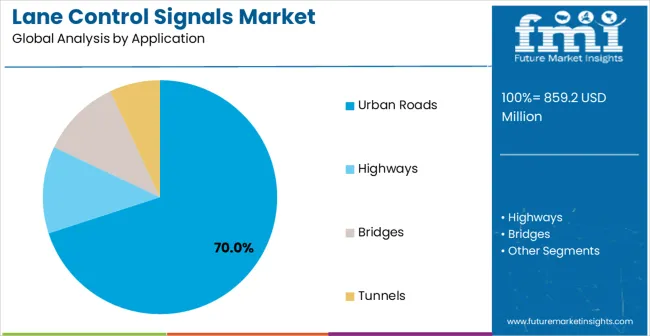
Urban roads applications are projected to represent 70% market share of lane control signals demand in 2025, underscoring their critical role as the primary application environment for dynamic lane management systems. Urban transportation authorities prefer lane control signals for their ability to manage complex traffic patterns efficiently, support congestion reduction initiatives, and provide real-time lane status communication while offering enhanced safety benefits for high-density traffic environments. Positioned as essential infrastructure for modern urban mobility management, lane control signals offer both traffic optimization advantages and accident prevention benefits.
The segment is supported by continuous growth in urban development projects and the growing implementation of smart city initiatives that enable advanced traffic management and real-time communication at the urban infrastructure level. Additionally, urban transportation authorities are investing in intelligent transportation systems to support dynamic lane control positioning and traffic flow optimization. As urban populations continue to expand and cities seek efficient traffic management solutions, urban roads applications will continue to dominate the application landscape while supporting infrastructure modernization and traffic safety enhancement strategies.
The lane control signals market is advancing steadily due to increasing government investments in intelligent transportation infrastructure and growing demand for dynamic traffic management systems that emphasize real-time lane control across highway and urban transportation applications. However, the market faces challenges, including high initial installation costs for comprehensive systems, technical complexity of integration with existing traffic management infrastructure, and maintenance requirements for outdoor display systems exposed to harsh weather conditions. Innovation in energy-efficient LED technologies and wireless communication integration continues to influence market development and expansion patterns.
The growing adoption of lane control signals in smart highway development and intelligent transportation system projects is enabling transportation authorities to develop infrastructure that provides dynamic traffic management while supporting integrated communication with traffic control centers and enhanced safety performance. Smart transportation applications provide superior traffic flow optimization while allowing more sophisticated infrastructure development across various highway and urban categories. Transportation authorities are increasingly recognizing the operational advantages of intelligent lane control positioning for modern infrastructure development and traffic management system integration.
Modern lane control signal suppliers are incorporating wireless communication capabilities, IoT connectivity, and real-time data integration systems to enhance traffic management effectiveness, improve system reliability, and meet transportation authority demands for connected infrastructure solutions. These technologies enhance operational efficiency while enabling new applications, including connected vehicle communication and automated traffic management systems. Advanced connectivity integration also allows transportation authorities to support centralized traffic control positioning and real-time traffic optimization beyond traditional static lane control signage.
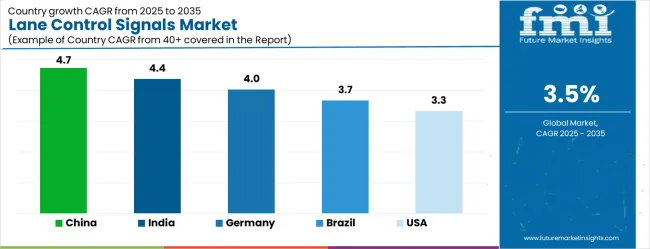
| Country | CAGR (2025-2035) |
|---|---|
| China | 4.7% |
| India | 4.4% |
| Germany | 4.0% |
| Brazil | 3.7% |
| USA | 3.3% |
| UK | 3.0% |
| Japan | 2.6% |
The lane control signals market is experiencing robust growth globally, with China leading at a 4.7% CAGR through 2035, driven by massive highway infrastructure development projects, expanding urban road networks, and government investments in intelligent transportation systems across major metropolitan areas. India follows at 4.4%, supported by rapid urbanization, growing traffic management challenges, and increasing adoption of smart city initiatives with advanced traffic control systems. Germany shows growth at 4.0%, emphasizing advanced traffic management technologies and highway infrastructure modernization programs. Brazil records 3.7%, focusing on urban mobility improvement and transportation infrastructure development across major cities. The USA demonstrates 3.3% growth, prioritizing highway safety enhancement and intelligent transportation system integration. The UK exhibits 3.0% growth, supported by traffic management modernization and infrastructure investment programs. Japan shows 2.6% growth, supported by advanced transportation technology adoption and highway infrastructure maintenance programs.
The report covers an in-depth analysis of 40+ countries top-performing countries are highlighted below.
Lane control signals market in China is projected to exhibit exceptional growth with a CAGR of 4.7% through 2035, driven by the country's massive infrastructure development programs and increasing investments in intelligent transportation systems across expanding highway networks and urban development projects. The country's growing focus on smart city development and traffic management optimization is creating substantial demand for advanced lane control technologies in both highway and urban transportation applications. Major transportation authorities and infrastructure developers are establishing comprehensive traffic management capabilities to serve both domestic infrastructure requirements and export market opportunities.
Revenue from lane control signals in India is expanding at a CAGR of 4.4%, supported by rapid urbanization, increasing traffic management challenges, and growing government investments in smart city development and transportation infrastructure modernization programs. The country's developing highway infrastructure and expanding metropolitan areas are driving demand for advanced traffic control systems across both urban and intercity transportation applications. International traffic technology companies and domestic infrastructure developers are establishing comprehensive distribution and installation capabilities to address growing market demand for intelligent lane control systems.
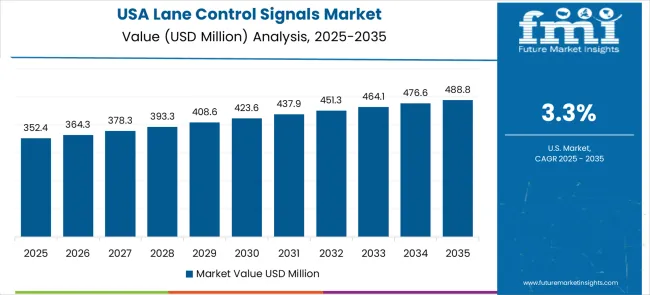
Lane control signals market in the United States is projected to grow at a CAGR of 3.3% through 2035, driven by the country's comprehensive highway infrastructure maintenance programs, federal transportation safety initiatives, and increasing adoption of intelligent transportation systems across major interstate and urban highway networks. The USA's established traffic management infrastructure and significant investments in highway safety enhancement are creating substantial demand for advanced lane control signal technologies. Leading transportation authorities and infrastructure contractors are establishing comprehensive deployment strategies to serve both federal highway projects and state transportation system modernization requirements.
Lane control signals in Germany is projected to grow at a CAGR of 4.0% through 2035, supported by the country's advanced traffic management infrastructure, comprehensive highway system, and established tradition of transportation technology innovation requiring high-performance traffic control systems. German transportation authorities and infrastructure developers consistently demand superior lane control signal products that meet exacting technical standards for both domestic highway systems and export market applications. The country's position as a transportation technology leader continues to drive innovation in lane control signal applications and performance standards.
Demand for lane control signals in Brazil is projected to grow at a CAGR of 3.7% through 2035, supported by the country's expanding highway infrastructure, urban mobility improvement programs, and increasing investments in transportation system modernization across major metropolitan areas and intercity corridors. Brazilian transportation authorities prioritize cost-effective solutions, operational reliability, and safety enhancement, making lane control signals essential components for both urban traffic management and highway infrastructure development. The country's comprehensive infrastructure development programs and federal transportation initiatives support continued lane control signal market development.
Revenue from lane control signals in the United Kingdom is projected to grow at a CAGR of 3.0% through 2035, supported by the country's comprehensive highway infrastructure, established traffic management systems, and ongoing investments in transportation technology modernization requiring advanced traffic control capabilities. British transportation authorities' emphasis on operational effectiveness and safety enhancement creates steady demand for high-performance lane control signal systems across both motorway and urban road applications. The country's focus on traffic management optimization and infrastructure maintenance drives consistent lane control signal adoption across both traditional and intelligent transportation system applications.
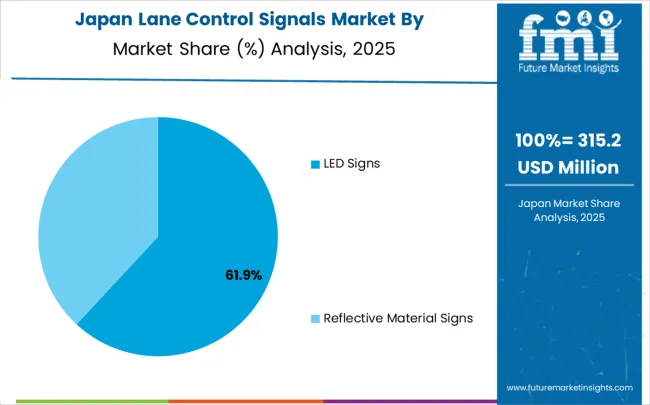
Lane control signals in Japan is projected to grow at a CAGR of 2.6% through 2035, supported by the country's advanced transportation infrastructure, sophisticated traffic management systems, and ongoing efforts to enhance highway safety standards through technology integration and intelligent transportation system development. Japan's transportation industry continues to benefit from its reputation for producing advanced traffic management technologies while working to address infrastructure maintenance challenges and improve operational efficiency through sustainable technology solutions.
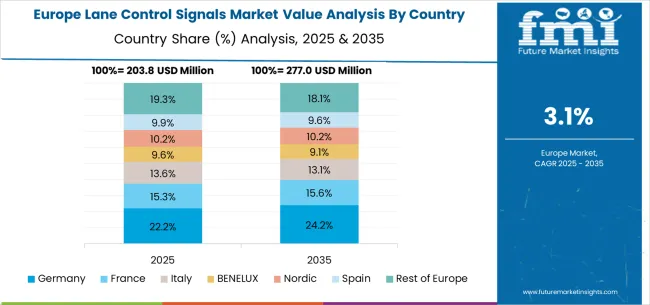
The lane control signals market in Europe is projected to grow from USD 211.8 million in 2025 to USD 298.4 million by 2035, registering a CAGR of 3.5% over the forecast period. Germany is expected to maintain its leadership position with a 28.2% market share in 2025, declining slightly to 27.8% by 2035, supported by its advanced highway infrastructure, comprehensive traffic management systems, and established transportation technology industry serving European and international markets.
France follows with a 19.5% share in 2025, projected to reach 19.8% by 2035, driven by extensive highway network modernization programs, urban traffic management initiatives, and growing investments in intelligent transportation system development across major metropolitan areas. The United Kingdom holds a 16.8% share in 2025, expected to decrease to 16.4% by 2035, supported by a comprehensive motorway infrastructure and traffic management system modernization, but facing challenges from infrastructure investment constraints and economic uncertainties. Italy commands a 13.2% share in 2025, projected to reach 13.5% by 2035, while Spain accounts for 10.8% in 2025, expected to reach 11.1% by 2035. The Netherlands maintains a 4.1% share in 2025, growing to 4.2% by 2035. The Rest of Europe region, including Nordic countries, Eastern Europe, Belgium, Switzerland, and Austria, is anticipated to hold 11.4% in 2025, declining to 11.2% by 2035, attributed to mixed growth patterns with faster expansion in some Eastern European markets implementing highway modernization programs, balanced by slower growth in smaller Western European countries developing intelligent transportation infrastructure projects.
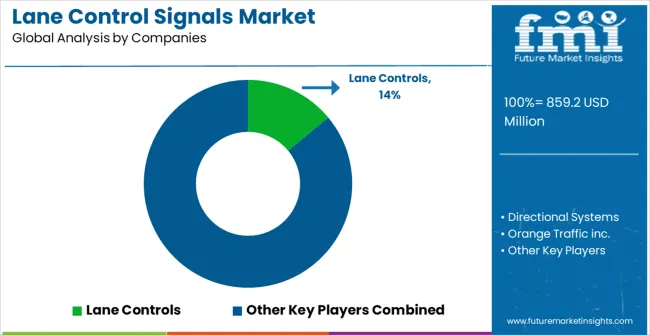
The lane control signals market is characterized by competition among established traffic management technology companies, specialized signal display manufacturers, and integrated transportation infrastructure suppliers. Companies are investing in energy-efficient LED technologies, wireless communication integration, weather-resistant display systems, and comprehensive traffic management software solutions to deliver reliable, high-performance, and connected lane control signal products. Innovation in display visibility optimization, IoT connectivity, and intelligent traffic management integration is central to strengthening market position and transportation authority satisfaction.
Orange Traffic Inc. leads the market with a strong focus on traffic management innovation and a comprehensive product portfolio, offering integrated lane control signal solutions that emphasize operational reliability and system integration capabilities. National Sign and Signal provides specialized traffic signage solutions with a focus on highway infrastructure applications and transportation authority requirements. Messagemaker Displays delivers advanced display technologies with a focus on visibility optimization and weather resistance performance. Sunrise SESA Technologies emphasizes intelligent transportation system integration with a focus on connected infrastructure solutions and traffic management platform compatibility. AD Engineering International focuses on traffic control technology development and comprehensive system integration capabilities.
Lane control signals represent critical infrastructure for modern traffic management, with the global market projected to grow from USD 859.2 million in 2025 to USD 1,212.0 million by 2035 at a 3.5% CAGR. LED-based systems dominate due to superior visibility, energy efficiency, and programmable capabilities, while urban roads applications lead demand driven by smart city initiatives and traffic optimization needs. Scaling market adoption requires coordinated action across government agencies, industry standards bodies, technology manufacturers, infrastructure suppliers, and financial enablers to advance intelligent transportation systems.
How Governments Could Accelerate Infrastructure Modernization and Market Growth?
How Industry Bodies Could Strengthen Market Development and Standards?
How Technology Manufacturers Could Drive Innovation and Market Expansion?
How Infrastructure Suppliers and Contractors Could Enhance Market Accessibility?
How Investors and Financial Enablers Could Unlock Market Potential?
| Items | Values |
|---|---|
| Quantitative Units (2025) | USD 859.2 million |
| Signal Type | Reflective Material Signs, LED Signs |
| Application | Urban Roads, Highways, Bridges, Tunnels |
| Regions Covered | North America, Europe, East Asia, South Asia & Pacific, Latin America, Middle East & Africa |
| Countries Covered | United States, Canada, United Kingdom, Germany, France, China, Japan, South Korea, India, Brazil, Australia and 40+ countries |
| Key Companies Profiled | Orange Traffic Inc., National Sign and Signal, Messagemaker Displays, Sunrise SESA Technologies, AD Engineering International, LaneLight, Versilis, Daktronics, SWARCO, and Wanco |
| Additional Attributes | Dollar sales by signal type and application, regional demand trends, competitive landscape, technological advancements in LED display systems, intelligent transportation system integration, energy efficiency optimization programs, and traffic management software development strategies |
The global lane control signals market is estimated to be valued at USD 859.2 million in 2025.
The market size for the lane control signals market is projected to reach USD 1,212.0 million by 2035.
The lane control signals market is expected to grow at a 3.5% CAGR between 2025 and 2035.
The key product types in lane control signals market are LED signs and reflective material signs.
In terms of application, urban roads segment to command 70.0% share in the lane control signals market in 2025.






Our Research Products

The "Full Research Suite" delivers actionable market intel, deep dives on markets or technologies, so clients act faster, cut risk, and unlock growth.

The Leaderboard benchmarks and ranks top vendors, classifying them as Established Leaders, Leading Challengers, or Disruptors & Challengers.

Locates where complements amplify value and substitutes erode it, forecasting net impact by horizon

We deliver granular, decision-grade intel: market sizing, 5-year forecasts, pricing, adoption, usage, revenue, and operational KPIs—plus competitor tracking, regulation, and value chains—across 60 countries broadly.

Spot the shifts before they hit your P&L. We track inflection points, adoption curves, pricing moves, and ecosystem plays to show where demand is heading, why it is changing, and what to do next across high-growth markets and disruptive tech

Real-time reads of user behavior. We track shifting priorities, perceptions of today’s and next-gen services, and provider experience, then pace how fast tech moves from trial to adoption, blending buyer, consumer, and channel inputs with social signals (#WhySwitch, #UX).

Partner with our analyst team to build a custom report designed around your business priorities. From analysing market trends to assessing competitors or crafting bespoke datasets, we tailor insights to your needs.
Supplier Intelligence
Discovery & Profiling
Capacity & Footprint
Performance & Risk
Compliance & Governance
Commercial Readiness
Who Supplies Whom
Scorecards & Shortlists
Playbooks & Docs
Category Intelligence
Definition & Scope
Demand & Use Cases
Cost Drivers
Market Structure
Supply Chain Map
Trade & Policy
Operating Norms
Deliverables
Buyer Intelligence
Account Basics
Spend & Scope
Procurement Model
Vendor Requirements
Terms & Policies
Entry Strategy
Pain Points & Triggers
Outputs
Pricing Analysis
Benchmarks
Trends
Should-Cost
Indexation
Landed Cost
Commercial Terms
Deliverables
Brand Analysis
Positioning & Value Prop
Share & Presence
Customer Evidence
Go-to-Market
Digital & Reputation
Compliance & Trust
KPIs & Gaps
Outputs
Full Research Suite comprises of:
Market outlook & trends analysis
Interviews & case studies
Strategic recommendations
Vendor profiles & capabilities analysis
5-year forecasts
8 regions and 60+ country-level data splits
Market segment data splits
12 months of continuous data updates
DELIVERED AS:
PDF EXCEL ONLINE
Control Network Modules Market Size and Share Forecast Outlook 2025 to 2035
Lane-level Navigation Market Size and Share Forecast Outlook 2025 to 2035
Controllable Shunt Reactor for UHV Market Size and Share Forecast Outlook 2025 to 2035
Control Room Solution Market Size and Share Forecast Outlook 2025 to 2035
Control Knobs for Panel Potentiometer Market Size and Share Forecast Outlook 2025 to 2035
Controlled-Release Drug Delivery Technology Market Size and Share Forecast Outlook 2025 to 2035
Controlled Environment Agriculture (CEA) Market Size and Share Forecast Outlook 2025 to 2035
Control Cable Market Size and Share Forecast Outlook 2025 to 2035
Signals Intelligence (SIGINT) Market Size and Share Forecast Outlook 2025 to 2035
Control Towers Market Size and Share Forecast Outlook 2025 to 2035
Lane Departure Warning (LDW) Market - Trends & Forecast 2025 to 2035
Controlled & Slow Release Fertilizers Market 2025-2035
Controlled Intelligent Packaging Market
Planetary Mixer Market Size and Share Forecast Outlook 2025 to 2035
Silane Coupling Agents Market Size and Share Forecast Outlook 2025 to 2035
Silanes Market Growth - Trends & Forecast 2025 to 2035
Biocontrol Solutions Market Size and Share Forecast Outlook 2025 to 2035
Biocontrol Agents Market Size and Share Forecast Outlook 2025 to 2035
Oil Control Shampoo Market Size and Share Forecast Outlook 2025 to 2035
Airplane And Helicopter Hangar Doors Market Size and Share Forecast Outlook 2025 to 2035

Thank you!
You will receive an email from our Business Development Manager. Please be sure to check your SPAM/JUNK folder too.
Chat With
MaRIA